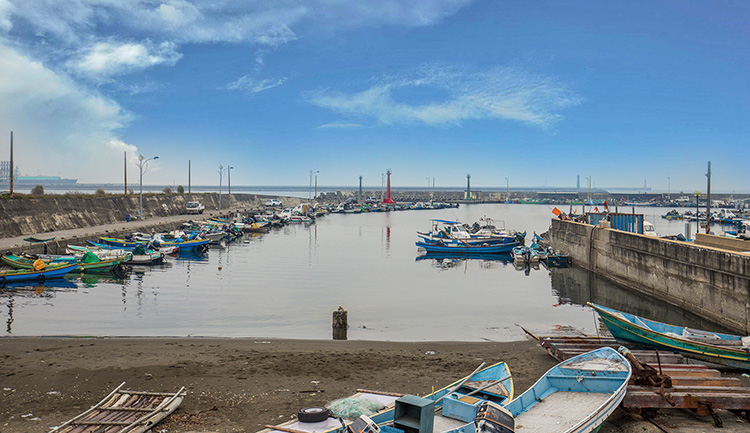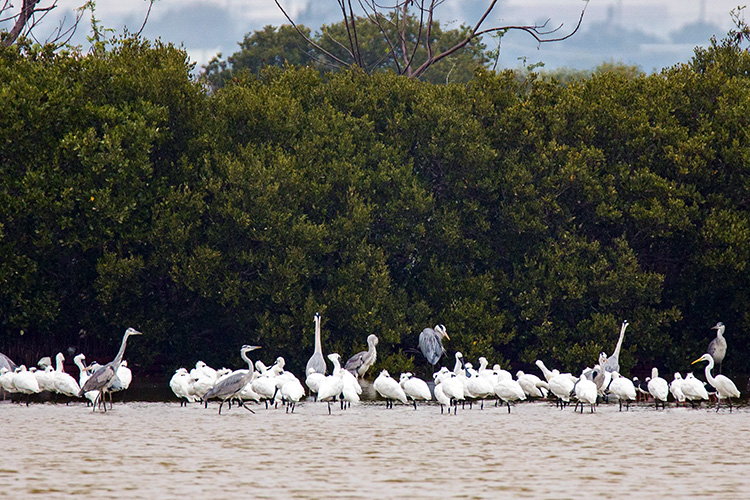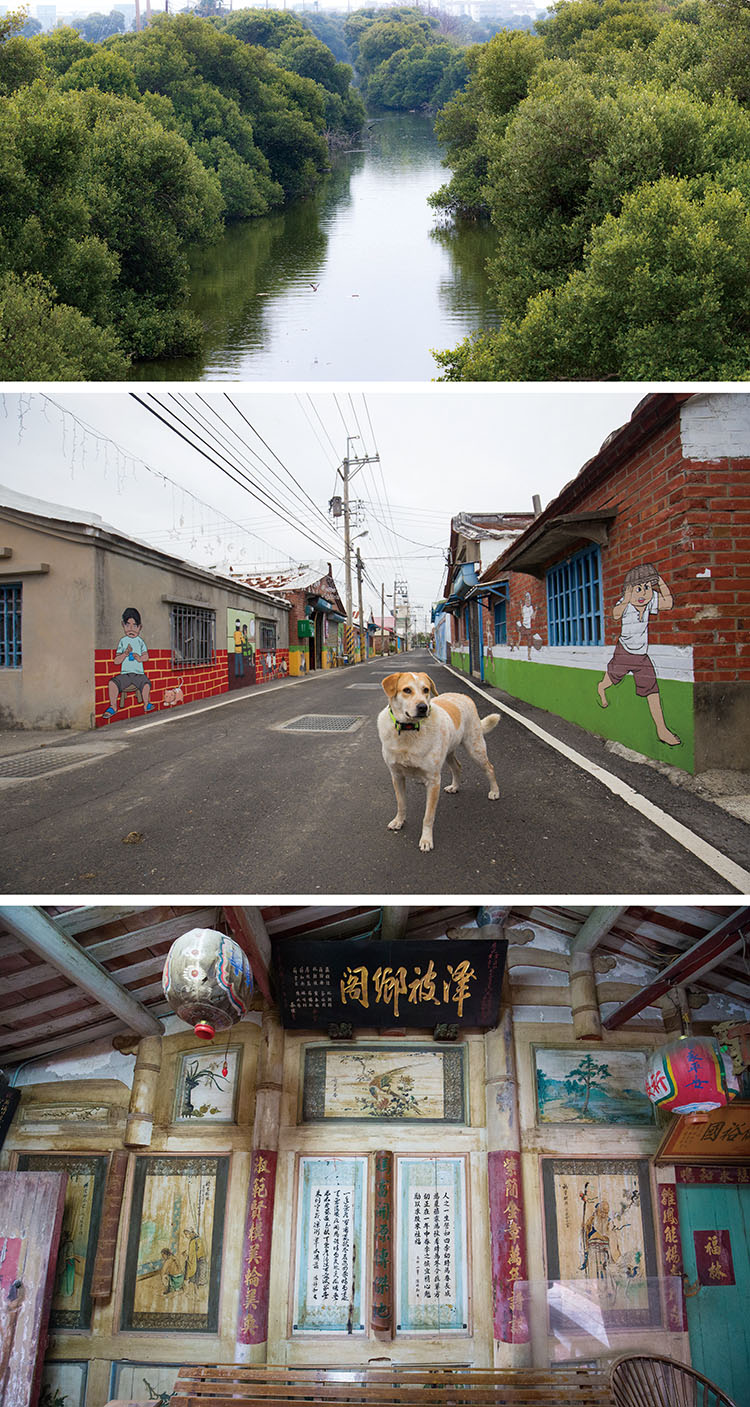Fish, Salt & Spoonbills: Yongan
Fish, Salt & Spoonbills: Yongan
◎English translation: Hou Ya-ting
◎Photos by Lian Wei-jhih
Yongan, one of Kaohsiung's coastal districts, is dominated by a thriving aquaculture industry. Its star products are grouper and giant grouper, leading to its nickname: “Home of Groupers.”

Yongan's Groupers
Yongan's grouper farmers have developed sophisticated aquaculture techniques. Local fish farmers benefit from the 15-degrees Celsius “diamond water” emitted by Yongan LNG (Liquefied Natural Gas) Receiving Terminal. The terminal, a unit of state-owned CPC Corporation, Taiwan, uses a great deal of seawater to warm the LNG, and the temperature of the water they extract from the ocean falls dramatically, typically to 15 degrees Celsius.
Taiwan's Environmental Protection Administration has ruled that effluent seawater can only be discharged back into the ocean if the temperature difference is no more than 4 degrees Celsius. Because heating up so much water would consume a huge amount of energy, local grouper farmers are encouraged to utilize this resource in their fish farms.
Groupers raised in seawater pools require an additional six months to mature compared to those farmed in freshwater, but their flesh is said to have a firmer, more attractive texture. Groupers are accustomed to water between 22 and 28 degrees Celsius; using the colder effluent water from Yongan LNG Receiving Terminal enables grouper farmers to keep their seawater pools at a comfortable 25 degrees Celsius, even at the height of summer.
Mr. Huang Shih-lu, a Yongan grouper farmer, points out that water temperature is crucial to grouper farming, and that at higher temperatures, infections are more likely. Because the LNG unit supplies the cold water they need, local grouper farmers need not spend so much on electricity. Mr. Huang mentions that Hsing-Ta Power Station, a coal-fired power plant, is planning to share hot effluent water with local fish farmers in wintertime. This should reduce the losses that sometimes occur when sudden cold snaps kill fish. Yongan's grouper farmers are always seeking to enhance the farming environment in order to cultivate better quality groupers.
Yongan Wetlands Park
 Yongan Wetlands Park, which covers 131 hectares, has a long history. The site was originally a 109-hectare salt production center that began operations in 1908. However, after just two years, it was wrecked by typhoons. In 1919, Mr. Chen Jhong-he – one of the most famous tycoons in Kaohsiung's history – took over Wushulin Salt Plant, expanding it to 133 hectares. Mr. Chen commissioned the building of a two-floor Baroque-style brick building to serve as the plant's office. The Former Wushulin Salt Plant Premises is now a city-designated historic site. The salt plant later changed owners, and by the early 1980s, Taiwan's salt industry was in decline, in part because new salt-production techniques had emerged. Wushulin Salt Plant ceased operations in 1984.
Yongan Wetlands Park, which covers 131 hectares, has a long history. The site was originally a 109-hectare salt production center that began operations in 1908. However, after just two years, it was wrecked by typhoons. In 1919, Mr. Chen Jhong-he – one of the most famous tycoons in Kaohsiung's history – took over Wushulin Salt Plant, expanding it to 133 hectares. Mr. Chen commissioned the building of a two-floor Baroque-style brick building to serve as the plant's office. The Former Wushulin Salt Plant Premises is now a city-designated historic site. The salt plant later changed owners, and by the early 1980s, Taiwan's salt industry was in decline, in part because new salt-production techniques had emerged. Wushulin Salt Plant ceased operations in 1984.
The former Wushulin Salt Plant currently belongs to Taipower, the state-run utility. The site has been abandoned for decades and is filled with mangrove swamps that attract various waterbird species. Kaohsiung City Government has recognized the old salt plant as a valuable wetland, and Taipower has given its consent for the city government to preserve it as a wetland park. In addition to undertaking environmental conservation work, the city government has established a tourist center and a walking path, so visitors can learn about nature and observe waterbirds. Each October, migrating Black-faced spoonbills can be seen foraging in the wetland. Visitors can reserve a tour guide for Yongan Wetland Park by calling the tourist center (07-6913037) at least one week in advance.
Those interested in the history of salt production can head to the adjacent salt village and see where salt plant workers used to live. Several of the original red brick houses have been preserved, although these days the village has just a few residents. Some of the houses have been decorated with bright illustrations to celebrate the history of salt production.
Huang's Historic House

Huang's Historic House is a traditional Chinese three-section residential compound with a quadrangle courtyard. Situated opposite Yongan Tianhou Taoist Temple, it was built by Mr. Huang Tuan in 1930. It was also the home of Mr. Huang Cing-rih, who once served as mayor of Yongan Township. Local residents therefore habitually call the house “the former township mayor's house.”
During construction, Mr. Huang Tuan commissioned Mr. Pan Chun-yuan, a painter renowned for his work in major temples, to paint eight pictures depicting historic themes. These were on wood in the central part of the main building. Over time, however, the colors faded and the images deteriorated. Eager to preserve this valuable culture asset, the Huang family asked Mr. Pan Li-shui (Mr. Pan Chun-yuan's son and a famous temple artist in his own right) to restore the antique paintings. As well as the art, visitors appreciate the dimensions of this traditional three-section residential compound and the symmetrical structure within the main building.
As dusk approaches, Yongan's fish farms and mangrove channels glitter in the late afternoon sun, exuding a tranquil ambiance. Endless energy churns the waters of the district's ubiquitous fish farms. Come to Yongan District and let the scenery imprint itself on your memory.